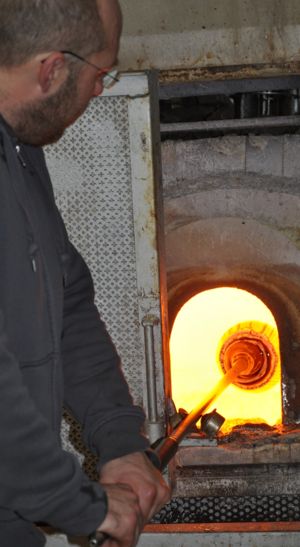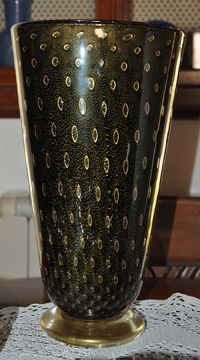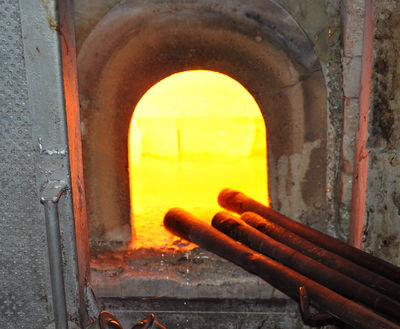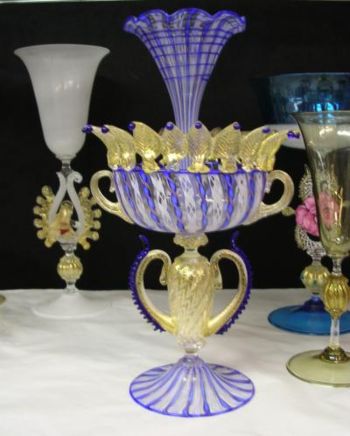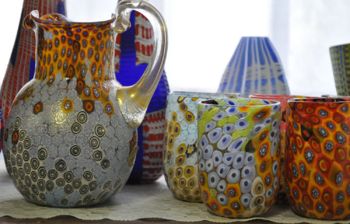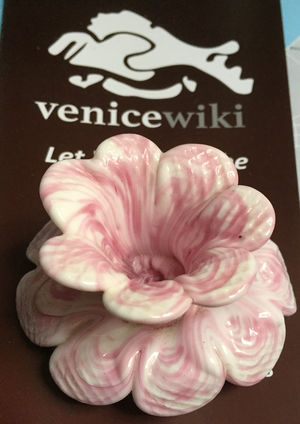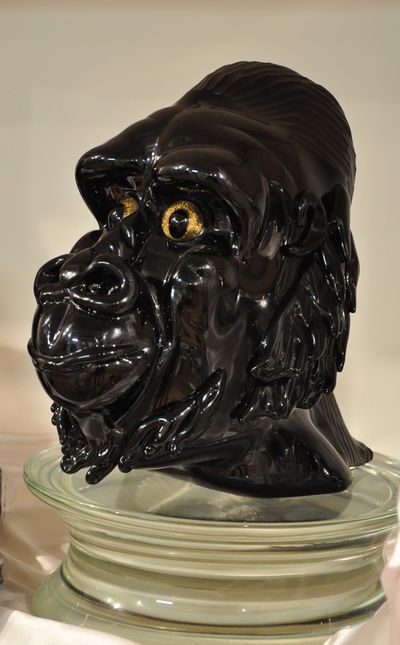Glass glossary
Da Venicewiki, il wiki di Venezia
| Riga 1: | Riga 1: | ||
| - | < | + | <poem> |
| - | + | [[Immagine:Lavorazione vetro.JPG|300px|right]]In [[Murano]] working the glass is an ancient art, that possesses terms and separate words for type of job or to identify those people whom produce determined objects. | |
| - | + | Also in the workmanship of the glass had therefore of the specific terminologies to give to the same workmanship, but also to a specific ended job, a name that identified it, that determines the specificity, that attributes the origin of the production of it. | |
| - | + | ||
| - | + | ||
| - | + | ||
| - | + | ||
| - | + | ||
| - | + | ||
| - | + | ||
| - | + | ||
| - | + | ||
| - | + | ||
| - | + | ||
| - | + | ||
| - | + | '''Avventurina ''': particular type of glass that is gotten with a very unusual procedure that consists of adding to concluded fusion determined quantity of first subjects, so that the copper can coagulate in small clots and you results lucent. The avventurina is best when the copper crystals are homogeneous in the whole fusion. Of the origin of the avventurina, invented to [[Book a visit to a Murano Glass Factory | |
| + | |Murano]] in 1620, the definition is representative that is given by the glassworker seventeenth-century Giovanni Darduin:“''la si dimanda Venturina, et con ragione, perché sortisse più da ventura che da scienza''”. (You defines Venturina for that the effect results more from fortune that from science). | ||
| - | + | [[Immagine:Baloton nero e oro.jpg|200px|left]]'''Baloton''': a particular workmanship that allows to englobe, to regular distances, some beads of air that, with the following laying of a further layer of glass, they remain you imprison in the glass, but well visible, forming an inside decoration, without consequences for the ended product. | |
| - | + | ||
| - | + | '''Bluino''': it is slightly a clear and compact transparent glass in the color. You gets with the cobalt addition in the mixture of preparation. Particularly proper for the decoration of the classical chandeliers muranesi, employee often comes in the wine glasses and in the pedestals of the blown glasses. | |
| + | |||
| + | '''Calcedonio''': The principal mineral for the preparation of the '''Calcedonio''' is the '''silver''', so denominated for the similarity to a variety of the stone hard call natural calcedonio, the ''agate zonata''. An opaque glass results with veins of various colors on dark fund, particularly difficult to prepare for the particular combination of the mineral launchings that compose it. | ||
| + | |||
| + | [[Immagine:Canne da soffio.jpg|left|400px]]'''Blowing pole''': pipe of ferrous material, cable, with which in the crucible of the oven is drawn for removing the part of fused glass that you/he/she will subsequently be worked. | ||
| + | |||
| + | '''Chemist''': is the name given to the entrusted person to perform the mixture of the flinty sand with the addition of the mineral ones that must go to fusion in the crucibles for the preparation of the pasta glassy purrs. The knowledge of the correct quantity of material to be used for the various ones ''stocks'' it gives a maximum importance to this figure, such to become a secret to hand down, only in point of death, of father in child. | ||
| + | |||
| + | '''Crystal''': Flinty sand with little intrusions of mineral in his composition. Few grams of iron oxidize for kilo of sand are enough to give a green- blue coloration to the glass. Also the percentage of firm it influences the transparency and hulling of the produced glass. In relationship to the percentage of firm inserted in the components, is defined '' short glass '' that with smaller quantity and '' long glass '' that with great, that increases also the workmanship of the glass. | ||
| + | |||
| + | [[Immagine:Tipetto.jpg|350px|right]]'''Filigrana''': consists in the insertion in a reed of transparent (crystal) glass of a colored soul, often white, that results absorbed, in the central part, of the reed. This is the base of a whole series of particular workmanships, from the ''reticello'' to the ''zanfirico''. When more reeds are twisted together they are gotten particular forms that seem some embroideries inside the glass. | ||
| + | |||
| + | '''Fiola''': ancient neck bottle along and wide belly. From this drift the ancient denomination of the teachers glassworkers of [[Murano]] with which are associated in school and affiliate in the special bulletin-board of category called '' Mariegola''. | ||
| + | |||
| + | [[Immagine:Bicchieri rigati.jpg|350px|left]]'''Incalmo''': technique of approach of different colors of glass settled together with warm so that to create, an only piece blown with separate colors. Only some colors can be united with this technique, in how much every color has own characteristics of cooling that, obviously you/they must be compatible, otherwise the different tensions would end up breaking the created object. | ||
| + | |||
| + | '''Lattimo''': the lattimo is an opaque white glass, conceived for resembling to the porcelain, when the Chinese porcelains started to be commercialized in Europe. The soul of the white filigree is in this material. It is gotten it opacifying the glass with oxide of pond. | ||
| + | |||
| + | '''Muffola''': Special oven to slowly lower the temperatures of the objects in glass just performed. The workmanships, the colors, the joints, have different tensions and they must slowly be loose with the purpose to eliminate her everybody. In contraire case the object is destined to inevitably break and to become useless. It is more often the object, more time must remain in ''muffola'', in some cases up to 36 hours. | ||
| + | |||
| + | [[Immagine:Caraffa e bicchieri murrina.jpg|350px|right]]'''[[Murrine Glass|Murrina]]''': the [[Murrine Glass]] is a piece of cut reed. It is usually gotten it with the approach of various types of colors in glassy pasta overlapped for forming the wanted sketch and brought to fusion. The result is a long reed whose section has the form and the wanted colors. Cut in disks of the varying length by few millimeters to 3 - 4 centimeters the gotten form is the murrina. The approach more murrine on a plate allows the workmanship of the same murrina both for the preparation of various objects, and for the decoration with the heat joining of great objects. | ||
| + | |||
| + | [[Immagine:Signoretto Lampadari.jpg|490px|left]]'''Glassy Pasta''': with this indication opaque glasses are found, very often of alive colors, and they are used for decorating both very particular chandeliers, the famous ones '' flowers in pasta '', both mirrors, with which the ornamental roses are prepared. | ||
| + | |||
| + | '''Reticello''': it is had as a variation of the filigree. With the reed in filigree two files are formed, of reed overlapped and cross, fused together they have a peculiar particularity: in the intersections of the reeds a small bead of air remains imprisoned and it appears to the center of the threads of the filigree giving her a sense of lightness. Are very appreciated the glasses performed with such technique, but also the dishes, the bottles and the cups. | ||
| + | |||
| + | [[Immagine:Fior in pasta.jpg|300px|right]]'''Rubino''': it is the resultant color from the addition of ''' pure gold''' to the glass. And' very particular in the vast range of colors producibili for the production of transparent glass. The rosy color is given by the use in the mixture of product vetrificante of ''' pure gold ''', otherwise the coloration would result darker, with an effect of burnt. | ||
| + | |||
| + | '''Zanfirico''': it is that technique of workmanship with which preferably dishes and glasses are performed. It is also it a variation of the filigree. In this case the produced reeds are woven in various forms until and approach so that glasses can be had blown that from the center they depart for the outside as you detach. | ||
| - | The links with the line LN (Laguna Nord) and from [[Burano]] and [[Cavallino]] stop only at the Lighthouse, where you can sail well to reach the islands of [[Vignole]] and [[Sant'Erasmo]] with Line 13. | ||
</poem> | </poem> | ||
==See also== | ==See also== | ||
| - | *[[Book a visit to a Murano Glass Factory]] | + | *[[Murano island]] [[Immagine:Gorilla.jpg|400px|right]] |
| + | *[[Book a visit to a Murano Glass Factory]] | ||
| + | *[[How to get to Murano]] | ||
| + | *[[What to see in Murano]] | ||
| + | *[[One day in Murano]] | ||
| + | *[[Basilic of Saint Mary and Saint Donato]] | ||
| + | *[[The Murano Glass Museum]] | ||
| + | *[[The glass colors]] | ||
*[[St. Mark's Square]] | *[[St. Mark's Square]] | ||
*[[Venice Boat]] | *[[Venice Boat]] | ||
| - | *[[ | + | *[[Murrine Glass]] |
*[[St. Nicholas patron of Murano glass-makers]] | *[[St. Nicholas patron of Murano glass-makers]] | ||
| - | |||
| - | ==How to make a golden goblet 24 carats - Come si esegue un bicchiere soffiato con oro 24 carati== | ||
| - | |||
| - | <div style="text-align:center;"> | ||
| - | <youtube size=l>GJhQP-GLhhU</youtube> | ||
| - | </div> | ||
*[[Venice]] | *[[Venice]] | ||
*[[Visit Murano Island and the Glass Factory]] | *[[Visit Murano Island and the Glass Factory]] | ||
Versione corrente
Also in the workmanship of the glass had therefore of the specific terminologies to give to the same workmanship, but also to a specific ended job, a name that identified it, that determines the specificity, that attributes the origin of the production of it.
Avventurina : particular type of glass that is gotten with a very unusual procedure that consists of adding to concluded fusion determined quantity of first subjects, so that the copper can coagulate in small clots and you results lucent. The avventurina is best when the copper crystals are homogeneous in the whole fusion. Of the origin of the avventurina, invented to [[Book a visit to a Murano Glass Factory
|Murano]] in 1620, the definition is representative that is given by the glassworker seventeenth-century Giovanni Darduin:“la si dimanda Venturina, et con ragione, perché sortisse più da ventura che da scienza”. (You defines Venturina for that the effect results more from fortune that from science).
Bluino: it is slightly a clear and compact transparent glass in the color. You gets with the cobalt addition in the mixture of preparation. Particularly proper for the decoration of the classical chandeliers muranesi, employee often comes in the wine glasses and in the pedestals of the blown glasses.
Calcedonio: The principal mineral for the preparation of the Calcedonio is the silver, so denominated for the similarity to a variety of the stone hard call natural calcedonio, the agate zonata. An opaque glass results with veins of various colors on dark fund, particularly difficult to prepare for the particular combination of the mineral launchings that compose it.
Chemist: is the name given to the entrusted person to perform the mixture of the flinty sand with the addition of the mineral ones that must go to fusion in the crucibles for the preparation of the pasta glassy purrs. The knowledge of the correct quantity of material to be used for the various ones stocks it gives a maximum importance to this figure, such to become a secret to hand down, only in point of death, of father in child.
Crystal: Flinty sand with little intrusions of mineral in his composition. Few grams of iron oxidize for kilo of sand are enough to give a green- blue coloration to the glass. Also the percentage of firm it influences the transparency and hulling of the produced glass. In relationship to the percentage of firm inserted in the components, is defined short glass that with smaller quantity and long glass that with great, that increases also the workmanship of the glass.
Fiola: ancient neck bottle along and wide belly. From this drift the ancient denomination of the teachers glassworkers of Murano with which are associated in school and affiliate in the special bulletin-board of category called Mariegola.
Lattimo: the lattimo is an opaque white glass, conceived for resembling to the porcelain, when the Chinese porcelains started to be commercialized in Europe. The soul of the white filigree is in this material. It is gotten it opacifying the glass with oxide of pond.
Muffola: Special oven to slowly lower the temperatures of the objects in glass just performed. The workmanships, the colors, the joints, have different tensions and they must slowly be loose with the purpose to eliminate her everybody. In contraire case the object is destined to inevitably break and to become useless. It is more often the object, more time must remain in muffola, in some cases up to 36 hours.
Reticello: it is had as a variation of the filigree. With the reed in filigree two files are formed, of reed overlapped and cross, fused together they have a peculiar particularity: in the intersections of the reeds a small bead of air remains imprisoned and it appears to the center of the threads of the filigree giving her a sense of lightness. Are very appreciated the glasses performed with such technique, but also the dishes, the bottles and the cups.
Zanfirico: it is that technique of workmanship with which preferably dishes and glasses are performed. It is also it a variation of the filigree. In this case the produced reeds are woven in various forms until and approach so that glasses can be had blown that from the center they depart for the outside as you detach.
